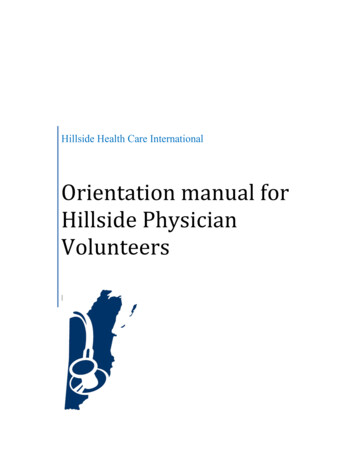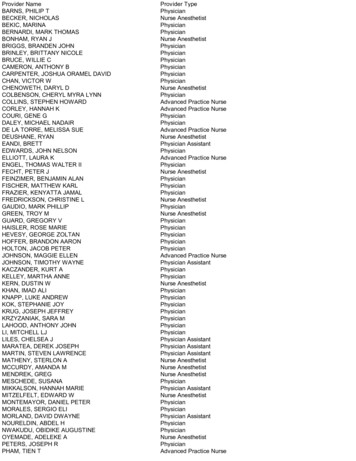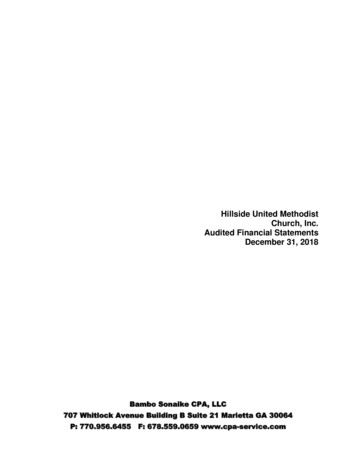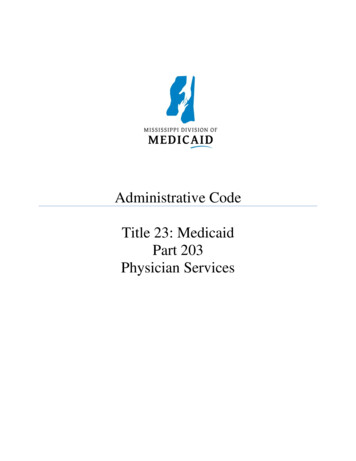
Transcription
Hillside Health Care Volunteers[2008]
HILLSIDE MISSION STATEMENT:Hillside Health Care International (HHCI) is a faith based, non-profit organizationdedicated to serving God by providing health care and disease prevention to the people ofSouthern Belize. HHCI is devoted to improving the Belizean quality of life throughmedical care, health education, and community outreach. HHCI promotes healthy globalattitudes by offering a culturally-rich educational program for medical volunteers thatchallenges them to better understand their role in international health care.HILLSIDE VISION STATEMENT:To ensure HHCI dynamically fulfills its mission by striving to build bridges—to themedically underserved, to the people living in our service areas, to our volunteers(medical and non-medical) who serve others through our program, to our partners, to ourstaff, and to long term financial sustainability.1 Page
HILLSIDE STATEMENT OF FAITH:Hillside Health Care International is a faith-based medical mission. The foundingmembers of the clinic were inspired by God and their Faith to start this clinic and servethe poor of southern Belize. The current leaders of HHCI continue to be inspired by Godand look to the Bible for inspiration and guidance as we move forward. We do not seethe mission of Hillside to be evangelical in nature, rather we believe our actions speaklouder than words and our service through medical care is how we live out our faith. Wedo not require anyone, patients or participants, to be of any particular faith but we do askthat you respect our beliefs and values and be willing to work in an environment wheresome may pray with patients or even gather together for reflection and worship. We trulylove and respect all people and this should be reflected in the daily operations of ourclinic.Preparation Please read through this entire document for information on Hillside’s Mission, yourresponsibilities during your term here, overview of healthcare in Belize, services/referralareas in the Toledo district, and other important information. Please read thru all portions of the website www.hillsidebelize.org. This site has beenreviewed and approved by the Hillside Health Care International Board of directors andis utilized by visiting students to help them become familiar with Hillside. Read through the clinic procedure (section L), for the students will rely on the MedicalDirector to know Hillside’s proper documentation procedures (SOAP notes), clinic flow,health protocols, referral procedures for lab tests, x-rays, and consults, etc. Qualityclinical care is our top priority. Read through the Community Health Education responsibilities (section I) and if you arevolunteering for a month or longer, come prepared to give a presentation on a topic ofyour choice. We are often in need of medications for our pharmacy here at Hillside. If you areinterested in bringing medications, please let the administrator know ahead of time so wecan get you a specific list of medicines we need and a copy of our formulary. Please tryto bring medications listed on our formulary and DO NOT BRING EXPIREDMEDICATIONS. It is best to bring medications in their packaging as it is essential tohave all medications labeled with an expiration date. Send the list of medications you2 Page
will be bringing to the Administrator at least 6-8 weeks (earlier if possible) before youarrive. This is to assure that the Ministry of Finance approves this import. If you declarewhat you bring in and do not have approval, you will be charged a 28% tax on theestimated value. With Ministry of Health approval, you may still be taxed, but only at a2% rate (environmental tax) Talking to previous doctors who have served as medical director is an excellent way toget a sense of what your experience will be like, and what you need to be prepared for.Please contact the administrator for contact information for these physicians. Come prepared to work within the established system and be flexible. Inorder to maintain consistency amidst the frequent turnover of physicians itis paramount to work with the long-term staff while avoiding the tendencyto try to change our systems. As a short-term volunteer, should you feelthat any changes are necessary, please talk with the Administrator and theExecutive Director first. Positive sustainable change requires theperspective that comes through months or years of experience. Many wellintentioned changes have been implemented by short term volunteers tothe detriment of the Hillside organization, clinic and staff.B. Mission of Hillside There are three main programs through which we try to achieve our goalsi. CLINICAL - Direct patient care including acute illnesses, disease prevention, andreferralsii. COMMUNITY - Outreach and education to communities and schools, includingpublic health initiatives in our villagesiii. EDUCATION – Teach our learners how to practice in a resource challenged,culturally diverse setting. Hillside works in a close partnership with the Belizean Ministry of Health (MoH) andattempts to provide services that will augment those already available through the MoH.3 Page
C. Responsibilities for all Hillside volunteer physicians1. Oversight of medical care delivered during all of Hillside’s clinical activities includingmobile clinics and the home visit program.2. Precepting medical/physician assistant students and medical residents during patientencounters for all Hillside clinical activities. Responsible for all care delivered by thesame.3. Facilitating the medical education of Hillside medical/physician assistant students andresidents through patient encounters, talks, case presentations, community healthprogram, etc.4. Ensuring that student and resident participants adhere to established clinical policiesincluding documentation guidelines.5. Completion of Hillside elective participant evaluations.6. Facilitate excellent communication between students, staff, administration, and theMinistry of Health.7. Presenting or helping to present on certain health related topics included in the rotationcurriculum of Hillside.D. Responsibilities for long term Hillside volunteer health care providers (1 year or more) Assisting the staff in the development of clinical policies and protocols when necessary. Assisting Hillside staff in development and implementation of the community healthprogram. Assisting Hillside staff in the orientation of Hillside elective participants and volunteerhealthcare providers. Completing weekly schedule of activities for students/residents and helping to deployclinical personnel as needed to meet our mission. Pharmacy oversight and assistance with determining medication needs and ordering ofmedications.4 Page
E. Overview of Health Care delivery in Belize and Toledo District The Ministry of Health (MoH) manages a country wide system of hospitals and clinics.The MoH divides Belize into 4 regions with each region possessing a lead hospital. TheSouthern Region includes the Toledo and Stann Creek districts. The Southern RegionalHospital is located in Dangriga, Stann Creek District, and is the main referral site withinthe region; the Toledo district hospital is located in Punta Gorda. Karl Heusner Hospital,located in Belize City, is the MoH tertiary hospital for the country. Patients may receivefree/low cost care at MoH facilities throughout the country, or, opt for more expensiveprivate facilities. Belize has a new National Health Insurance program that provides care to all registeredcitizens. It is new and in development. It is likely that Hillside will adjust its patient careactivities to meet the needs within this new system. The Southern Regional Hospital in Dangriga is the main referral point for patientsrequiring a higher level of service of care in the Toledo district. Southern RegionalHospital provides general surgical services, and its staffing includes a general surgeon,OB/GYN and an internist. Most other specialties are only found in Belize City. Theexception is orthopedic cases which are referred to Belmopan, and any high level cases,which are referred directly to Karl Huesner. Punta Gorda (PG) hospital provides basic inpatient services and maternity care; it isstaffed by primary care physicians, the majority of whom come from Cuba. Regularsurgical services are not offered; however, there are occasionally surgical teams thatcome from the U.S. There are occasional specialists that visit PG hospital and the PGpolyclinic staff generally knows that schedule. The Medical director of the PG hospital isDr Raju. Outpatient care is coordinated thru one of 2 PCPs (Primary Care Clinics) or“Polyclinics.” These are located in PG and San Antonio. Public Health (Maternal andChild Health or MCH) Nurses are responsible for immunizations, prenatal clinics, andwell child exams. In PG they also have TB, hypertension and diabetes clinics, a vectorcontrol unit (malaria, dengue, etc), a public health inspector (water standards, restaurant5 Page
inspection, etc) and the district health education office (HECOPAB). There are also twopsychiatric nurses who provide mental health services to the district under the supervisionof a psychiatrist currently practicing in Belize. The Medical Director of the PGPolyclinic is Dr Garcia. Each PCP has 2 or 3 rural health clinics. These are staffed by a rural health nurse and/ ora physician. The rural health nurse acts in many ways like a family nurse practitioner(and provides a significantly higher level of service then that offered by the CNAs in thevillages) These villages have “Health Centers”, which are good sized buildings equippedwith living quarters for the nurse. PGs clinics are in Santa Ana and Big Falls, and SanAntonio’s clinics are in Columbia, Pueblo Viejo, and Santa Teresa. Each village in Toledo (and elsewhere in Belize) is intended to have a Certified NursingAssistant (CNA), also called a village health care worker. The CNAs work out of avillage “Health Post”, which frequently is a small one room structure. CNAs havevarying levels of training, but are generally limited to very basic medical care. They areprovided with Tylenol, benadryl, chloroquine and with the ability to perform malariasmears, wound dressing, etc. CNAs are paid a small salary and usually perform unrelatedwork to support themselves. The CNAs provide the first line of care to the villagers; theyrefer patients to a higher level of care when necessary. Some villages also have volunteerTraditional Birth Attendants (TBAs). At present, Hillside is the only other primary care provider other then the MoH in theToledo District. Hillside works in areas that the MoH is unable to adequately cover withthe system above. We work closely with the MoH to determine our Mobile sites andschedules, and coordinate referrals and services. The Belize Family Life Association (BFLA) is a countrywide NGO which has an officein every district. The Toledo district office is in Punta Gorda. BFLA providesreproductive and sexual health services. It is staffed by a nurse, Paulina Cus. BCVI is a countrywide NGO which has an office in Punta Gorda next to the hospital.BCVI provides eye care and is staffed by an optometrist. She refers to an ophthalmologistin Belize City. The office is open M, W, F.6 Page
“Bush Doctors” are utilized by some of the Toledo population, particularly in the ruralareas. Much of the Toledo population will try home herbal remedies prior to visiting ahealth care provider. Universal Health Services and Belize Medical Associates are private clinics/hospitals inBelize City. Those able to afford to do so, often choose the private facilities over MoHfacilities. Loma Luz is another such facility in Cayo District. Many births are performed in the home, particularly in the villages. TheMoH encourages woman to have their first child at the PG Hospital; deliveries at thehospital are normally performed by midwives. Short term volunteer health care providers (missionary teams, US military teams,individual providers, etc) often visit the Toledo District to conduct clinics. These visitsare supposed to be coordinated through the MoH. They may visit villages without ourknowledge. Any concerns about these medical missionary teams should be brought to theattention of the Clinic Manager.F. Hillside’s History and Current Structure Hillside opened in 1999 as a collaboration between the Jericho RoadFoundation International (JFRI) based in the Chicago area, and the Medical College ofWisconsin (MCW).The Sisters of Mercy (SOM) subsequently became a third partner.The organization underwent reorganization in early 2005 and is now called HillsideHealthcare International (though the clinic continues to be best known as Jericho Road bythe local population). The organization has a state-side board of directors, the president ofwhom is Dr. Russ Robertson of Northwestern University Feinberg School of Medicine.The Stateside CEO is Jeff Hartman DPT, MPH. The CEO and the stateside boardoversee all operations of the organization. The Hillside Clinic team is headed by its manager, Penny Leonard and clinical directors,Dan and Maria Thibault. They report directly to the CEO and board. The remaining staffat Hillside consists of salaried local employees and volunteer health professionals.7 Page
The clinic is supported entirely through student tuition fees, private individual andorganizational donors. The clinic currently provides all services at no cost. We do ask allnon-Belizeans to donate 25 for the care received. Schools such as Marquette University, the University of Iowa, University of Wisconsin,and Drake Universtiy have a relationship with Hillside and send students and faculty ofdifferent medical professions to us for monthly rotations. In 2004 a partnership withConcordia Nursing School in Wisconsin was established, sending students forinternational experience under the tutelage of an RN. Medical/PA students and medical residents have been performing electives at Hillsidesince its inception and are an integral component of the Hillside Health care team.Participants are primarily from the US, though more recently there have been participantsfrom several other countries, including the UK, Australia, Canada, among others. Vehicles. Transportation is a critical part of our mission, as our fleet of vehicles isessential to getting our staff and patients around. Become familiar with the currentvehicle policy that assures that the main transport vehicles are not used for outsideactivities. We generally discourage any personal use of Hillside vehicles. If you havequestions or concerns, they should be directed to Evert, the Facilities Manager.G. Overview of Hillside Clinical Activities Clinical activities currently consist of the onsite clinic, mobile clinic and the home visitprogram. Along with its clinical work, Hillside participates in community outreach andeducation. Additionally, physical and occupational therapy services have been providedby volunteers since 2004. For more information on PT/OT, see section H. For moreinformation on community health, see section I. Onsite clinic is conducted Monday through Friday morning 8am-noon. The morninghours are designed to coincide with the regional market conducted in PG on Mon, Wedand Fri mornings. Villagers from throughout Toledo District bus into PG early in themorning and return to their villages on buses that depart PG at 11:30 or noon. Hillsideattempts to make itself available to these villagers. Additionally, Hillside provides ashuttle service to and from PG central square Wednesday and Friday mornings. The8 Page
shuttle will depart Central Square for clinic at 9am and return to Central Square once allthe patients shuttled in have been seen. Because patients from rural and urban areasattend the onsite clinic, the patient mix (and therefore the conditions encountered) tendsto be diverse. For more information how the clinic is run, see Clinic Procedure (sectionL). Mobile clinics to villages are conducted Monday through Thursdays. The villages arechosen by the MOH with our consultation. Presently Hillside covers San Jose, BlueCreek, and Aguacate in the San Antonio area; Laguna, San Marcos, Big Falls, andBarranco in the Punta Gorda area. The exact villages we visit may indeed change as theneeds of the district change. Each Wednesday afternoon students present on assigned topics pertinent to the diseasesthat they are seeing at the Eldridge clinic and mobiles. Along with this the preceptor mayhave a short presentation on a medical subject that they have prepared, or a local healthprofessional is invited to speak to the group. Each Friday the students are provided lunch in conjunction with a cultural presentation.These may be an area homes, restaurants, or at the education center. The session isgenerally finished by 2:30 in order that the group can have a longer weekend. Home visits are provided for those people in the PG area who are unable to easily accessa medical facility. Currently there are approximately 50 patients; these include theelderly, disabled children and adults. Home visits are generally conducted by a Hillsidenurse. Visiting physicians will do joint home visits on complicated patients and doperiodic chart reviews. Home visit patients are currently separated into groups based onlocation to better organize the visit schedule. During each month, all patients in eachgroup are visited at least once, though frequently a patient’s condition will requiremultiple visits. Home visits are designed to provide medical care while also providing anopportunity for social interaction for persons who are often very isolated.9 Page
H. Physical Therapy and Occupational Therapy program Physical therapy (PT) and occupational therapy (OT) services have been provided to theentire Toledo District in the past. Presently, there is no ongoing program, although groupsof PT/OT come for short visits one to two times per year. Services are provided mainlythrough home visits, often in conjunction with CARE Belize, an organization thatprovides physical therapy to disabled children under the age of 6. Common conditionstreated include musculoskeletal disorders (fracture, amputation, muscle strain/sprain,deconditioning, bursitis), neurological disorders (stroke, spine injury), pediatric disorders(cerebral palsy, spina bifida, Down syndrome, developmental delays) and elderlyconditions (arthritis, loss of balance, deconditioning). OT aims to attain the highestfunctional independence of patients so they can do the day-to-day activities that areimportant to their health and well-being. This includes activities of daily living or anyoccupation which enables the patient to sustain them or contribute to their family andcommunity. OT treatment strategies focus on upper extremity strengthening, fine motorskills, and cognitive and communication skills. PT aims to alleviate impairment,developmental delay and functional limitation cause by the conditions listed above. Anassessment is performed, therapeutic interventions are designed and implemented, andclients are taught injury prevention. In contrast to OT treatment, PT treatment focuses onstrengthening the larger muscle groups to allow patients to perform skills such as rolling,transferring, sitting, standing, and walking as independently as possible. Referral formsfor these services are available in the clinic.I. Community Health Program The Hillside Community Health Program was created with a dual role. It seeks to servethe local community by increasing knowledge about clinical and public health. It alsoworks to provide students with an understanding of community health in Belize tocomplement the medical training they receive during clinic time. The program works tomove students toward the following goals:10 P a g e
-Recognize the delivery of health in a multi-cultural region of theworld and gain an understanding of the political, cultural and historical contextand its impact on health and health care delivery.-Recognize prevalent cross-cultural and underserved issues in primarycare, and gain an understanding of how this knowledge can be applied to apractice in the participants’ home country.-Understand and appreciate the uniqueness of the many cultures ofsouthern Belize including the Maya, Garifuna, East Indian and Creole cultures.-Understand the benefits and challenges of working with communitiesand recognize strategies to overcome the challenges.-Develop the knowledge, skills, and attitudes necessary to effectivelywork with communities and to identify and appropriately access communitybased resources.-Understand and appreciate how psychological, economic, spiritual,social and biological factors inter-relate to affect one’s health.-Demonstrate skills in cross-cultural communication including taking apatient-centered history and counseling in an effective manner. Community outreach and education takes many forms. Students, with oversight from thestaff, develop presentations for schools, organizations and health fairs. Students attendpresentations on various topics pertaining to Belizean community health. Outreach hasincluded radio interviews of Hillside staff. Hillside has developed working partnershipswith the MoH and other organizations involved in the health of the Toledo population.These organizations include HOPE (for the elderly), CARE Belize (disabled children),PLENTY (sustainable jobs, school gardens), Toledo HIV/AIDS committee. Activities inpartnership with these organizations affirm another component of Hillsides’ communityoutreach. Hillside is striving to broaden its partnerships to include such organizations asUNICEF and the Pan American Health Organization (PAHO). Hillside currently employsa part-time Community Liaison who oversees the elective participants’ involvement andeducation in community health. In order to screen the area children for preventable diseases and to discover children thatwould benefit by referral for vision correction, disability evaluations, surgical repairs, it11 P a g e
is the goal of Hillside to perform a screen physical exam on all children in our catchmentarea. Along with this Hillside will work with the MOE to help implement their healtheducation curriculum. This curriculum has been deemed by the Hillside staff as veryadequate. Teachers may only need some in-service training or help in implementing thiscurriculum. We ask that you play a role in the implementation of the community health program inorder to reiterate to the students the importance of community health in regard to medicalcare. Continuous reinforcement by a medical professional supporting the need for linkingcommunity health and clinical medicine demonstrates to students that both are necessaryin order to provide optimal healthcare. As medical director this responsibility includesparticipating in Wednesday afternoon conferences and presenting a monthly health topicto students.J. Pharmacy Any prescription written in the clinic needs to be signed by the medical preceptor/staff toverify proper dose and length of treatment. All medications coming in or out are recordedto maintain our inventory and assess needs. Prescriptions written in the clinic should be written so patients can understand them withno abbreviations. Although we try to maintain consistency in our inventory it is often necessary tosubstitute one medication with another from the same class, i.e. captopril for enalapril. Short term supplies of medications that are not available in Belize should be used withgreat caution. For example, if these meds are for chronic conditions such as diabetesmellitus, it is difficult to sustain the patient on the med once the donated supply runs out. Controlled substances are generally not kept at clinic. Those on the Belizean formularycan be obtained, if necessary, through the PG Hospital pharmacy. Since our supplies are limited, you must restrict the amount of medications given.Generally, a one month supply is given. Seldom more than 40-50 Tylenol or Ibuprofen12 P a g e
are prescribed. This is more strictly enforced when dispensing MoH medications in themobile clinics. If there is a choice in medications, prescribe the ones that will expire first. At thebeginning of each month an updated formulary with expiration dates is printed andavailable. There are some medications available at the PG polyclinic that Hillside doesnot have and we are able to prescribe those and have them filled by the patient there. There are 2 pharmacy students that are available for consultation with the medicalproviders to help in choice of the correct medication given the formulary constraints.Use their knowledge to guide you. Remember that there is far less resistance to common medications here in Belize than inthe U.S.K. Guidelines for student/resident oversight Encourage professional behavior and appearance at all times. Stress confidentiality at all times. See all patients being cared for by medical/PA students and PA attendings. If a resident has obtained a temporary Belizean license, they may see patients on theirown if the attending feels comfortable with this. All student/resident charts need to be reviewed; student and non-licensed resident chartsmust be cosigned. Give feedback to participants early and often. Prescriptions can only be signed by a practitioner with a Belizean license. Students will be working with the FNP and RNs seeing home visit patients, withoversight as needed by the medical director. Students are not allowed to make medicationchanges for these patients on their own, but should discuss these with the FNP andmedical director. Students/Residents are encouraged to take their time with patients; however, they mustalso be encouraged to perform care in a timely manner. At onsite clinic, patients oftenhave to catch a bus or the Hillside shuttle back to town. Encourage the students/residentsto keep their notes concise; if clinic becomes busy, students/residents are still required torecord a complete note but may work on the chart after the clinic is over.13 P a g e
The medical preceptor should help the students/residents to develop their ability inthinking through and writing out an assessment and plan for every patient. Rememberthat a clearly documented assessment and plan on each patient is essential in providingcontinuity of care between rotating physicians. Resident physicians may act as licensed physicians if they have obtained approval. If theydo not have approved licenses, they will not be able to act independently. The medicaldirector should work closely with the resident physician to offer supervision andeducation as needed. Major learning points for students/residents will be:1) Practicing medicine with limited diagnostic and treatment options.2) Communicating and working effectively across varied cultures.L. Clinic Procedure (same as Hillside Clinic Medical Student Manual) Daily clinic hoursMon thru Friday 8am –noonMonday thru Thurs are mobile clinics. Expect to leave by 8am.Return time varies based on location. Intake: staff checks in patients and gets basic vitals including a malaria smear if indicatedper Belize Ministry of Health Guideline (smear for any pt with fever 99.6 or higher).Charts are placed in an inbox in the order that they should be seen. Students are to pickup charts in order (sometimes families are seen together). Students are required to get anyadditional vitals (respiratory rate, pulse, pulse oximetry). Charting: all charting is done in order to provide consistent quality patient care. The lefthand side of the chart holds the patient’s medical history if they have been seen atHillside before. A current problem list should be kept on all patients. Some acceptableabbreviations, appropriate SOAP notes and examples of chart notes are listed below. Allmedical students are provided with this charting information via email before arriving atHillside and in paper form upon arrival.14 P a g e
References: there are reference books in the cabinets in the clinic. Internet is available viathe student computer for any online resources. Prescriptions: students will write prescriptions, but you must sign them in order for theHillside pharmacy to fill them. If Hillside does not have a medication, use the largerprescription forms in the clinic, the patient must have two copies to take with them andmake sure you sign both of them. The patient will be able to fill the prescription at PGhospital or elsewhere in Belize. Please insure prescriptions are legible and are written insimple English so the patient can read them at home and take their medicationappropriately. Please be sure to check the patient’s allergies. All dispensed meds shouldbe clearly listed in the chart with dose, instructions, and quantity. If a prescription isgiven to be filled elsewhere, please document this as well. Testing: There are a limited number of tests available to be run at the clinic. Theseinclude UA dips and Pregnancy tests. Document results in the SOAP note. A limitednumber of tests can be performed at the PG hospital and these are posted in theconsultation room. There is a form to complete, including test requested, diagnosis, andsignature. The patient can take the form to PG hospital or other testing center. Be sure toremind patients that they must bring back a paper copy of their test results when theyfollow up. Please call Mr. Tommy Johnson at the PG lab if you have questions about theavailability of a particular test. Tests not done at PG Hospital will require a patient totravel to a testing facility and pay for the test themselves. This often makes testsimpractical. If you believe a test is necessary, please discuss with your patient and or oneof the staff. Information on our malaria protocol, oral rehydration protocol, a temperature conversionchart, clinical evaluation of diabetics on o
2. Precepting medical/physician assistant students and medical residents during patient encounters for all Hillside clinical activities. Responsible for all care delivered by the same. 3. Facilitating the medical education of Hillside medical/physician assistant students and










